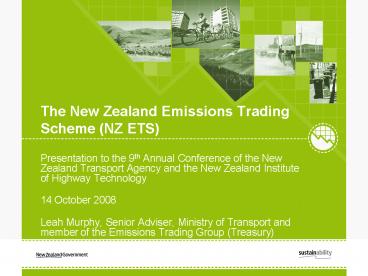The New Zealand Emissions Trading Scheme NZ ETS - PowerPoint PPT Presentation
1 / 27
Title: The New Zealand Emissions Trading Scheme NZ ETS
1
The New Zealand Emissions Trading Scheme (NZ ETS)
- Presentation to the 9th Annual Conference of the
New Zealand Transport Agency and the New Zealand
Institute of Highway Technology - 14 October 2008
- Leah Murphy, Senior Adviser, Ministry of
Transport and member of the Emissions Trading
Group (Treasury)
2
Emissions Trading
- Part 1 Emissions Trading 101
- Part 2 New Zealand Emissions Trading Scheme
- Part 3 Transport in the New Zealand Emissions
Trading Scheme - Part 4 Impacts on contractors and asset land
managers of the NZ ETS - Questions
3
How does the Kyoto Protocol work?
- Aims to reduce emissions of developed countries
(and economies in transition) to 5 below 1990
levels (in total) during 2008 to 2012 - Binding targets for 37 industrialised countries
- NZ target is for 100 of 1990 emissions 309
million tonnes of CO2e - Targets get met via national measures, emission
trading (AAU, RMU), clean development mechanism
(CER) and joint implementation (ERU) - The estimate of the cost of New Zealands
obligation at 31 May 2008 is NZ480 m (Treasury)
4
How does Kyoto fit into the big picture?
(Note that this is illustrative only, and
reflects the outdated net position projection as
reported in July 2007)
5
What is happening around the world?
- Australia Australian Carbon Pollution Reduction
Scheme 2010 - Europe EU ETS 2005
- US/Canada Western States Climate Initiative
2012 Regional Greenhouse Gas Initiative 2009 - Federal scheme McCain/Obama
- Japan Voluntary Emissions Trading Scheme
2005
6
Emissions trading 101
- Firms must surrender units to match the emissions
they are responsible for - Firms may either reduce emissions, receive units
for free from the government, or buy/sell units
in the commercial trading market - A limit on the number of emission units in the
market creates a cap on emissions and gives the
units an economic value - The price signal changes behaviour across the
economy
7
New Zealand Emissions Trading Scheme
8
New Zealand Emissions Trading Scheme
UN Framework Convention on Climate Change and
Kyoto Protocol
9
New Zealand Emissions Trading Scheme
10
New Zealand Emissions Trading Scheme
11
New Zealand Emissions Trading Scheme
12
New Zealand Emissions Trading Scheme
13
Emissions trading 101 Example
- Why are we here?
- What action is needed?
14
Core design features
- All sectors, all 6 Kyoto gases by 2013
- Internationally linked
- Absolute rather than intensity-based obligations
one unit surrendered per tonne emitted - Initial free allocation at 90 of 2005 emission
levels for eligible industry and agriculture - Free allocation to pre-1990 forest owners of 55
Mt CO2 - Reflects international rules (i.e. Kyoto
Protocol) - Compliance financial penalty plus make-good
- Self-assessment model for monitoring, reporting,
verification and enforcement
15
Timing of entry
16
Who are the Participants? (1)
17
Who are the Participants? (2)
18
Who are the (potential) Participants? (3)
19
How will the ETS affect our economy?
- Important to adjust soon as the costs of
inaction outweigh the costs of action - NZ economy already faces the marginal cost of
emissions via the Kyoto Protocol - Macroeconomic modelling shows that the impacts of
Kyoto obligations are negligible - ETS designed so firms face the marginal cost
for their emissions - Structural change anticipated but in a good
way - existing technologies and carbon-friendly
techniques to be applied where cost-effective - move to a lower carbon economy
- change in thinking carbon simply another a cost
of production, just as labour, energy and capital
are now
20
Liquid Fossil Fuels The Details
- ETS obligation
- the person who imports or removes obligation
fuels from a refinery (if total amount exceeds
50,000 litres per year) - the person who purchases more than 10 million
litres of jet fuel per year - Methodology litres of obligation fuel X emission
factor tonnes of emissions (CO2e) - Emission factor accounts for CO2, CH4, N2O and
oxidation. - Obligation fuels include petrol, diesel, jet
fuel, av gas, light and heavy fuel oils AND any
other liquid fossil fuel - Exemptions fuel used for an international trip
biofuels
21
Reporting and Surrender dates
- Voluntary reporting 1 January 2009 to
- 31 December 2009
- First report due 31 March 2010
- Mandatory reporting 1 January 2010
- First compliance period 1 January 2011
- First surrender date 30 April 2012
- Reporting/surrendering Annual
22
Impacts on Transport Fuels?
23
Point Carbon EU ETS and CER
- EU ETS
- 10 Oct 08 EUAs for DEC 2008
- 22.25
- Graph represents last 30 days
- Secondary CER (OTC)
- 30 Sept 08 CER for DEC 2008
- 19.05
24
Issues and opportunities for transport sector?
- Cost of greenhouse gases emissions will be
internalised into economic system - Changing investment incentives taking price of
carbon into account - Need to understand differences between
- corporate greenhouse gas emission reporting
- ETS obligations (especially with upstream points
of obligation) - concept of and aspiration to be carbon neutral
- voluntary greenhouse gas markets
25
Issues and opportunities for transport sector?
- Modal shift to less carbon intensive modes
(potentially out of cars/trucks and onto PT,
trains and ships) and implications for planning
and design of road network in long-term - Image for New Zealand and individual firms
- Bring forward green technology
26
Implications for highway construction
- Increased cost of fuel and transport services
- Emissions intensive materials
- Manufactures of Cement, steel and bitumen are all
trade-exposed industries - Sectoral approaches to international agreement
(to sit along-side a Kyoto-like agreement) - Asset and land managers (NZTA and local
authorities) - Understanding forestry implications of ETS
- removal of trees (forests),
- land management
27
Questions?
Domestic aviation 3.5































